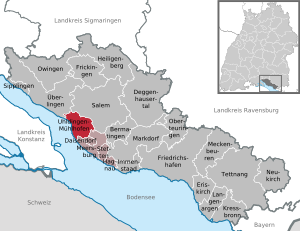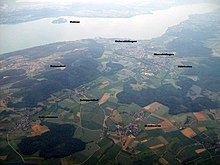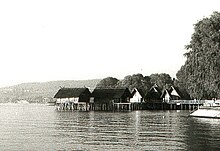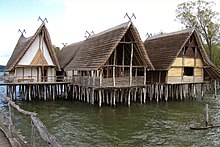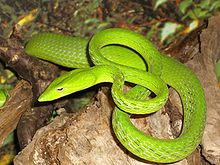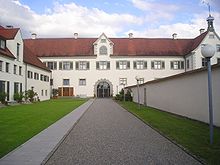Uhldingen-Mühlhofen
| coat of arms | Germany map | |
|---|---|---|

|
Coordinates: 47 ° 45 ' N , 9 ° 15' E |
|
| Basic data | ||
| State : | Baden-Württemberg | |
| Administrative region : | Tübingen | |
| County : | Lake Constance district | |
| Height : | 429 m above sea level NHN | |
| Area : | 15.66 km 2 | |
| Residents: | 8305 (December 31, 2018) | |
| Population density : | 530 inhabitants per km 2 | |
| Postal code : | 88690 | |
| Area code : | 07556 | |
| License plate : | FN, TT, ÜB | |
| Community key : | 08 4 35 066 | |
| Address of the municipal administration: |
Aachstrasse 4 88690 Uhldingen-Mühlhofen |
|
| Website : | ||
| Mayor : | Dominik Männle ( independent ) | |
| Location of the community Uhldingen-Mühlhofen in the Lake Constance district | ||
Uhldingen-Mühlhofen is a municipality in the Lake Constance district , in Baden-Württemberg , Germany . The community is a state-approved resort .
geography
Geographical location
Uhldingen-Mühlhofen is located on the north shore of Lake Constance about seven kilometers east of Überlingen and three kilometers west of Meersburg , with a view of the island of Mainau , the Bodanrück and, to the south, to the countries of Switzerland and Austria on the other bank, to the Alpine massif. The community area is 15.66 square kilometers. Between the town of Unteruhldingen (southwestern part of the village of Uhldingen-Mühlhofen) in the south and the hamlet Seefelden (western part of the village of Uhldingen-Mühlhofen) in the north flows the Seefelder Aach in the nature reserve Seefeld Aach mouth in the Lake Überlingen (Northwest part of the upper lake ). The 55 hectare nature reserve is the habitat of numerous rare fish, insects, water birds, reptiles and amphibians, some of which are threatened with extinction. The great crested grebe and the pochard are to be mentioned as animal population, the white willow and the common snowball as plants .
structure
The community of Uhldingen-Mühlhofen was created through the merger of the formerly independent communities of Oberuhldingen, Mühlhofen and Unteruhldingen as part of the community reform in Baden-Württemberg . It is made up of the districts of Mühlhofen (with the hamlet Gebhardsweiler, the homestead Hallendorf and the houses Im Fölle), Oberuhldingen (with the hamlets Obermaurach and Seefelden, the homestead Oberhof and the houses Birnau , Reissmühle, Schloss Maurach and Wilhelmshof) and Unteruhldingen . With an area of 811 hectares, Oberuhldingen forms the center of the municipality and its most populous district. Unteruhldingen is a traffic-calmed resort and forms the tourist center of the community.
| coat of arms | Part location | surface |
|---|---|---|
| Mühlhofen | 631 ha | |
| Oberuhldingen | 811 ha | |
| Unteruhldingen | 122 ha |
climate
Uhldingen-Mühlhofen has a sunny climate with 2077 hours of sunshine in 2008, the third most in Germany. The weather station Unteruhldingen-Pfahlbaumuseum ( 47 ° 43 ′ 48 ″ N , 9 ° 13 ′ 48 ″ E ; 398 m above sea level ), which provided this data, is networked by the Meteomedia weather service .
history
Until the 19th century
There is evidence that the shores of Lake Constance in the Unteruhldingen area were settled by hunters and fishermen as early as the Stone Age and the Bronze Age , i.e. between 4000 and 850 years before Christ, as archaeological finds show. At the time of the Roman Empire there may have been a port facility there; Coin finds from the 1st century AD speak for it. Oberuhldingen was on the Roman road from Meersburg to today's Salem Valley . The remains of a Roman estate were also found there.
The parish of Seefelden was possibly founded as early as the 7th century (it was first mentioned in a document in 1165) and, along with Bermatingen , Aufkirch and Reichenau Monastery, is one of the original churches of the northern Lake Constance area, so it would be a witness of the first wave of Christianization by the Franconian Empire . She was subordinate to the Bishop of Constance .
The place name Uhldingen is first documented in 1058 as Oweltinga / Ouweltingen ; later Uoldingen and Ueldingen . The place bears the name of the clan elder Owalt from Alemannic times. Mühlhofen is first mentioned in 1165 as Mulnhoven .
In the 12th century, the Salem Imperial Abbey began to purposefully buy property in and around Uhldingen. A Cistercian monastery was probably founded in Seefelden in 1227 , which was under the care of Salem. A few years later it was relocated to Baindt at the instigation of the Salem abbot Eberhard von Rohrdorf .
In 1348 the plague struck the area; two wayside shrines in the hostel hallway remind of this.
On the hill of Zihlbühl, in the so-called Knappenhöhle, gold was dug in the Middle Ages , which was only found in sparse quantities in the soft molasses sand .
On the lower Lichtenberg stood a castle that was destroyed in the Swabian War in 1499 and demolished in 1525. It was the seat of the Lords of Oberrieden.
From 1264 the villages Oberuhldingen, Mühlhofen and Seefelden belonged to the territory of the Salem Imperial Abbey . Unteruhldingen was in the neighboring area of the county of Heiligenberg , which from 1516 belonged to the Fürstenberg dynasty. A document from Emperor Friedrich Barbarossa documents the existing shipping traffic between Unteruhldingen and Constance for the year 1175 . Since 1222 the districts (Unter-) Uhldingen have been differentiated as port and Oberuhldingen.
The port towns of Maurach and Unteruhldingen were reloading points for goods from the Salem Valley and for the salt that Salem imported from the monastery's own salt mines in the Salzkammergut . A sunken salt ship is still lying on the bottom of the lake in front of the Unteruhldinger ship landing site. The Bishop of Constance also owned it. From 1733 the Uhldinger port was the main port of export for the county of Heiligenberg.
After the secularization in 1803/1804, the places passed to the Grand Duchy of Baden and became the independent communities of Oberuhldingen, Unteruhldingen and Mühlhofen.
Incorporations
From 1939 until the district reform in 1973, these communities belonged to the Überlingen district , and since then to the Lake Constance district. On January 1, 1972, Unteruhldingen, Oberuhldingen and Mühlhofen merged to form the municipality of Uhldingen-Mühlhofen.
Population development
| year | 1871 | 1900 | 1933 | 1950 | 1961 | 1970 | 1987 | 1991 | 1995 | 2005 | 2010 | 2011 (census) | 2015 |
| Residents | 888 | 1,752 | 1,734 | 2,433 | 3,194 | 4,539 | 5,521 | 6,480 | 7,243 | 8.003 | 7.910 | 7,809 | 8,068 |
politics
Administrative association
Uhldingen-Mühlhofen has merged with the city of Meersburg and the communities of Daisendorf , Hagnau and Stetten to form a community administration association.
Municipal council
The municipal council has 18 members. The local elections on May 26, 2019 led to the following result:
|
City council election 2019
Turnout: 61.9% (2014: 52.9%)
% 30th 20th 10
0
24.3%
19.9%
14.6%
8.1%
17.0%
11.3%
4.9%
Gains and losses
|
mayor
- Former municipality of Oberuhldingen
- until 1972: Anton Keßler
- Former municipality of Unteruhldingen
- 1967–1972: Walter Bühler
- Former municipality of Mühlhofen
- until 1972: Eugen Schaible
- Uhldingen-Mühlhofen
- 1972 (Office Administrator): Walter Bühler
- 1972–1996: Karl-Heinz Weber (Free Voters)
- 1996-2004: Ralph Bürk ( GREEN )
- 2004–2020: Edgar Lamm (CDU)
- since 2020: Dominik Männle (independent)
coat of arms
The coat of arms of the municipality of Uhldingen-Mühlhofen symbolizes the blossoming of the three districts with three stylized roses on a red background. The three segments with blue waves on a white background stand for Lake Constance and the Seefelder Aach , which flows from the Salem Valley through the municipality and flows into Lake Constance at Seefelden.
Culture and sights
ways
Parallel to the lakeshore, the Lake Constance cycle path leads from Meersburg along the shore to Unteruhldingen, then crosses the nature reserve in front of Seefelden and then continues to Überlingen. The Bodensee-Rundweg also leads through Unteruhldingen and partly deviates from the Bodensee-Radweg. But the path from Meersburg to Überlingen, which is closer to the shore, can also be used by hikers. There is also the approximately two-kilometer-long historical journey through time , which reflects 10,000 years of landscape and cultural history at over 20 stations. It contains test plantings from the Stone Age and information from the Ice Age to modern times.
Museums
- The Pfahlbaumuseum Unteruhldingen is an open-air museum that presents archaeological finds and replicas of pile villages from the Stone and Bronze Ages . It is the tourist attraction in the community with over 270,000 visitors annually. The first pile dwellings were reconstructions from 1922, which were designed on the basis of excavations in the moor near Bad Schussenried and at the Federsee . The idea to build the first two houses in Unteruhldingen was conceived by the local mayor Georg Sulger, the Überlingen city archivist Victor Mezger and the local chief executive Hermann Levinger in 1921 and supported after a lecture by Hans Reinerth about the excavations at Federsee. Since its foundation in 1922, the museum has been sponsored by the Verein für Pfahlbau- und Heimatkunde e. V., with currently 610 members. The archeologist Hans Reinerth, controversial because of his Nazi past, headed the museum in Unteruhldingen from 1945 to 1990. The archaeologist Gunter Schöbel has been responsible for the museum and its affiliated research institute since 1990 . In 1996 a new museum was expanded with archive and exhibition rooms. The number of reconstructed pile dwellings grew from 13 to 23 thanks to the support of several European projects.
The pile dwellings are part of the UNESCO World Heritage Site of Prehistoric Pile Dwellings around the Alps, which was created in 2011 . - The state-recognized reptile house founded in Unteruhldingen in 1975 , in which snakes, lizards and spiders are kept , is also considered a museum, albeit with live animals . At first it was housed in the old school building that now houses the guest house. From 1993 to 2005 the reptile house was located in Sipplingen , since 2005 it has been housed in a new building right on the outskirts of the car park in Unteruhldingen. The reptile house finances itself exclusively through the entrance fees and the sale of souvenirs. As a sanctuary for reptiles, the house has received more and more animals over the years that have been confiscated or that the original owner could no longer or no longer want to keep. The fact that all animals are doing very well here can also be seen in the age of the animals. The oldest animal, a Cape cobra (naja nivea), has been in the reptile house since 1976.
- In the Spek factory in Mühlhofen, which was a machine weaving mill for decades, a cultural establishment with an attached restaurant has been established.
- The Auto & Tractor Museum has over 350 mobile exhibits and depicts urban and rural life over the past 100 years. The tour of life in the city takes you past elegant limousines from the 1920s and 1930s, small cars from the post-war period and larger vehicles from the 1960s and 1970s. In the rural life department , you can experience an old farming village, shoemakers, cooper and many other craftsmen. There is also an old school and household shop. Typical shops from that time are exhibited, as well as various living rooms from the respective era. Affiliated is the Jägerhof restaurant with around 200 seats in the ambience of an old farm. The exhibition is located on around 10,000 square meters in the Gebhardsweiler district and has been open since spring 2013. The Fritz B. Busch collection has been integrated into the museum since spring 2017.
Buildings

- The Birnau pilgrimage church , which Peter Thumb built for the nearby Salem Monastery from 1746 to 1759, is visible from afar in the municipality . The baroque architectural style, the splendid rococo furnishings by Joseph Anton Feuchtmayer and Gottfried Bernhard Göz and the picturesque view from the church forecourt over the headland of the ship landing stage in Unteruhldingen, the Mainau and the lake make the Birnau a tourist destination on Lake Constance.
- The baroque Maurach Castle below the pilgrimage church once served the monastery as a farm building and port and the abbots as a summer residence and is now rented out as a conference center.
- The hamlet of Seefelden has retained its village character to this day. The local parish church of St. Martin has a Gothic apse (15th century) and a nave from around 1700. The tower, the oldest part of the church, dates from the 12th century ( Romanesque ). The neo-Gothic winged altar dates from 1912 and depicts the life of Martin von Tours in nine panels ; the confessionals were carved in Joseph Anton Feuchtmayer's workshop and were in Birnau until 1806. The parish of Seefelden may have been founded as early as the 7th century. It was first mentioned in a document in 1165.
- The Unteruhldingen local chapel dates back to 1505. There is a baroque high altar here , which was originally located in Seefelden, as well as some wood-carved figures from the construction period. It used to be subordinate to the municipality of Seefelden.
- The historic Unteruhldingen town hall , once a bathhouse, also dates from the 16th century.
- Oberuhldingen also has a historical sight from the 16th century with the St. Wolfgang Chapel. The Salem abbot Stephan I. Jung had it furnished in the Baroque style around 1711; the altarpiece shows a view of the Salem monastery.
- The chapel on the cemetery in the Mühlhofen district, built in the early 1960s, was demolished in 2011 and replaced by a new building costing around 400,000 euros.
- In Mühlhofen is the historic Zum Sternen inn , which was built in 1788 by Abbot Robert zu Salem in the late Baroque style with a three-storey hipped roof . Today's inn was originally a branch of the Salem monastery . The three-story attic was used to dry the paper made in this house. The paper from the Mühlhofer paper mill was considered to be of particularly high quality. In addition to the simple hand-made paper, the fine paper with a watermark for the Salem scriptorium was made from rags. The coat of arms of the Salem abbot Robert Schlecht still adorns the facade of the hotel today. The house still has extensive vaults and still has the three-story loft. Beer production started here at the end of the 18th century. The taproom, in which cheaper beer was served, was called stars because of the star that marked the room , because the marriage of water and fire as superimposed triangles formed a star. For this reason, many inns in southern Germany have this name.
Memorials
During the Nazi era , prisoners from the Dachau concentration camp set up a branch of the concentration camp ( Aufkirch ) near Überlingen . The prisoners worked in Überlingen from October 1944 to April 1945 on extensive underground facilities. This is also the case at the Goldbacher tunnel , where Friedrichshafen armaments factories were supposed to be protected from bombing .
Of the at least 168 prisoners who did not survive the construction period, 97 are buried in the Birnau concentration camp cemetery about 200 meters east of the Birnau pilgrimage church , above federal road 31 . This Birnau concentration camp cemetery can be reached on foot from the parking lot above the Birnau monastery church and the B31.
The names of the dead concentration camp prisoners were far as is known in the book The tunnel of Oswald Burger listed in memory and investigating for unknown relatives. There is a monthly guided tour through the Goldbacher tunnel on Obere Bahnhofstrasse.
Painting by Unteruhldingen
- Waldemar Flaig : Landscape near Unteruhldingen. In the archive of the Bodenseekreis art collection in Salem Castle .
Regular events
In addition to the traditional Carnival, there is also the stilt building marathon (May), the harbor festival (July) and the Fischerhock (September).
Economy and Infrastructure
economy
Around 12 km² of the municipal area are still used for agriculture and forestry , with fruit and wine growing predominant in agriculture . There are 25 small burners in the community of Uhldingen-Mühlhofen (as of December 2011).
Part of the working population commutes to the surrounding larger cities, such as Überlingen and Friedrichshafen . On site, the residents mainly work in medium-sized businesses, with the focus shifting continuously from the manufacturing to the service industry for years . Tourism in particular plays an important role.
traffic
Uhldingen-Mühlhofen is on federal highway 31 . The original route near the lake was relocated to a new, wider route west of Oberuhldingen around 1950 and in the direction of Meersburg in the mid-1980s. The traffic-calmed resort of Unteruhldingen is now away from through traffic on the much less traveled Meersburger Strasse along the lake shore. The federal road with traffic noise protection runs through the suburb of Oberuhldingen.
The community is also served by Deutsche Bahn trains on the Stahringen – Friedrichshafen line , known as the Bodenseegürtelbahn. The station is located in the Oberuhldingen district. From 1901 to 1950 a branch line made the connection to Unteruhldingen. Today several bus lines connect Uhldingen-Mühlhofen with Salem , Überlingen, Friedrichshafen, Meersburg and other neighboring communities. The community belongs to the Bodenseekreis and is therefore part of the Bodensee-Oberschwaben Verkehrsverbund ( bodo ).
The ships of the Bodensee-Schiffsbetriebe transport passengers from Constance via Meersburg and Unteruhldingen to Überlingen. In particular, there is a connection to the island of Mainau . The harbor in Unteruhldingen is located in a sheltered bay.
Public facilities
In addition to sports and leisure facilities, the community's infrastructure includes childcare, a school, a music school, a library and a natural beach. The indoor swimming pool and sports hall are located in the Mühlhofen district.
Personalities
Honorary citizen
- 1996: Karl-Heinz Weber, Mayor
- 2020: Hans Joachim Jaeger, longtime councilor and first deputy mayor
Other personalities
- The painter Otto Antoine (1865–1951) lived and worked in Unteruhldingen since the Second World War , where he also died.
- 1857/58: Stephan Schuhmacher built the organ for the Catholic parish church of St. Martin together with Eduard Hieber .
- Rudolf Hagelstange lived in Unteruhldingen from 1948 to 1968 .
- Hans Walter Berg (1916–2003), journalist and ARD's first Asia correspondent, lived in Uhldingen from 1962 to 2003.
literature
- Überlingen and the Linzgau on Lake Constance. Theiss, Stuttgart 1972. ISBN 3-8062-0102-1 .
- Oswald Burger: The Stollen. Überlingen, 6th edition 2005. ISBN 3-86142-087-2 (documentation on the Aufkirch concentration camp, Goldbacher Stollen, short section on the Birnau concentration camp cemetery).
- Oswald Burger, Hansjörg Straub: The Levingers. A family in Überlingen. Eggingen 2002, ISBN 3-86142-117-8 (the Überlingen associations around 1900, the idea for the Unteruhldingen pile dwelling museum and the time of the Grand Duchy and the state of Baden are also described).
- Hermann Schmid: The Unteruhldinger market and shipping law (1179–1872). With views of Überlingen, Meersburg, Mainau, Salem and documented enclosures , in: Writings of the Association for the History of Lake Constance and its Surroundings. 105th year 1987, pp. 39-64 ( digitized version ).
- Gunter Schöbel : The Uhldinger Zeitweg ... 10,000 years of history around Unteruhldingen. Series of publications by the Pfahlbaumuseum Unteruhldingen, Volume 6. Zanker, Markdorf 2005. ISSN 0946-0519 .
Web links
Individual evidence
- ↑ State Statistical Office Baden-Württemberg - Population by nationality and gender on December 31, 2018 (CSV file) ( help on this ).
- ↑ a b c d e f Uhldingen-Mühlhofen. Strong together! In: The region introduces itself. We are here . Special supplement of the Südkurier from November 19, 2010, p. 11.
- ↑ a b c d e f g h i j k l m Holger Kleinstück: Uhldingen-Mühlhofen. From the Stone Age to the Modern Age . In: The region introduces itself. We are here . Special supplement of the Südkurier from November 19, 2010, p. 11.
- ↑ Rügen holds the tip . In: Südkurier from January 3, 2009
- ↑ The hours of sunshine of the previous year on t-online.de from January 2, 2009
- ^ Federal Statistical Office (ed.): Historical municipality directory for the Federal Republic of Germany. Name, border and key number changes in municipalities, counties and administrative districts from May 27, 1970 to December 31, 1982 . W. Kohlhammer, Stuttgart / Mainz 1983, ISBN 3-17-003263-1 , p. 503 .
- ^ Result of the City Council Uhldingen-Mühlhofen 2019
- ↑ Holger Kleinstück: “I'm thrilled”: Dominik Männle is delighted about his victory in the mayoral election in Uhldingen-Mühlhofen. In: suedkurier.de. Südkurier , March 23, 2020, accessed on April 2, 2020 .
- ↑ Stefan Hilser and Holger Kleinstück: Dominik Männle wins mayoral elections: the candidate with administrative experience wins the race. In: suedkurier.de. March 23, 2020, accessed April 2, 2020 .
- ↑ hk: cemetery receives new chapel . In: Südkurier of January 27, 2011
- ^ Südkurier-Grafik: Orlowski / Source: Hauptzollamt Ulm: Number of small burners . In: Hanspeter Walter (hpw): The old monopoly is running out . In: Südkurier of December 17, 2011
- ↑ Hans Sauer: "Oldenburg kale and Peking duck". The Asia correspondent Hans Walter Berg was born in Varel 100 years ago. In: Kulturland Oldenburg. Issue 3.2016 No. 169, pp. 54–56 oldenburgische-landschaft.de (PDF).

